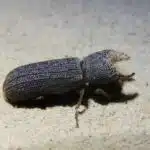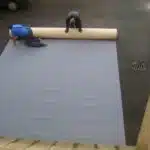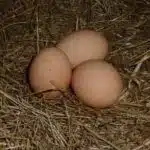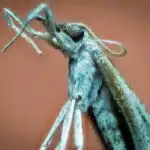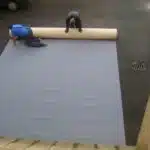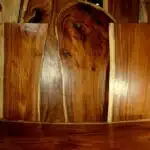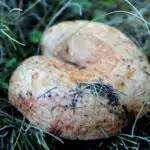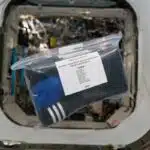Carpet beetles are a common household pest that can cause significant damage to fabrics, carpets, and other materials. These small insects are often difficult to detect and can quickly multiply if not properly addressed. To effectively get rid of carpet beetles, it is essential to identify the source of the infestation.
As a pest control expert, my experience has taught me that finding the source of an infestation is critical for successful eradication. In this article, I will provide you with practical tips on how to locate the source of a carpet beetle infestation in your home and eliminate the problem once and for all. By following these steps, you will be able to protect your belongings from further damage and ensure a pest-free environment for your family.
Understanding Carpet Beetles
Carpet beetles are one of the most destructive pests that can infest a home. They have a life cycle that consists of four stages: egg, larva, pupa, and adult. The eggs are laid on fabrics or other materials that serve as food for the larvae. After hatching, the larvae begin to feed immediately, and they can cause significant damage to carpets, clothing, and other household items.
Dietary habits are an essential aspect of understanding carpet beetles. These pests feed on a wide variety of organic materials, including natural fibers such as wool, silk, and cotton. They also consume feathers, pet hair, dead insects, and even food crumbs. Carpet beetle larvae can often be found in dark areas such as closets or under furniture where they have easy access to their preferred food sources.
To control carpet beetles effectively, it is crucial to understand their life cycle and dietary habits. By identifying areas where carpet beetle infestations are likely to occur and taking steps to eliminate their food sources, homeowners can prevent these pests from causing significant damage. In the next section, we will discuss how to identify carpet beetle damage so that you can take action quickly if an infestation occurs in your home.
Identifying Carpet Beetle Damage
Understanding the behavior and biology of carpet beetles is essential in identifying their source and preventing their infestation. Now that we have a basic idea of what these pests are, it’s time to learn how to find the source of their infestation. Identifying damage patterns is the first step in discovering where the source could be.
Carpet beetle larvae cause most of the damage, so they are the ones to look out for when trying to identify an infestation. The larvae feed on natural animal fibers and can cause significant damage to carpets, clothing, and furniture. Commonly mistaken signs of an infestation include small holes in fabrics or carpets, shed skins, or fecal pellets. However, these signs could also indicate other pest problems.
The best way to locate the source of a carpet beetle infestation is by conducting a thorough inspection of your home. Look for areas where natural fibers are present, such as carpets, closets with wool clothing or blankets, pantries with cereals or pet food bags made from animal fibers. Once you locate where the larvae are feeding and breeding, it’s time to take action to get rid of them. In the next section, we will discuss how to recognize carpet beetle eggs and larvae so that we can identify them more quickly and accurately.
- Nestled bullet point list:
- Tips for finding the source of carpet beetle infestations:
- Conduct a thorough inspection of your home.
- Focus on areas with natural animal fibers.
- Prevention measures:
- Clean regularly
- Store fabrics in sealed containers
- If you suspect an infestation, contact a pest control professional for treatment options.
Recognizing Carpet Beetle Eggs And Larvae
Carpet beetle eggs are white or yellowish-white, oval and about 1.5 millimeters long. They are laid in lint, dust, pet hair and other debris. Carpet beetle larvae are reddish-brown in color, with alternating light and dark stripes on their bodies. They can typically be found in carpets, rugs, furniture, and animal nests. To identify carpet beetle eggs and larvae, it is important to look for the presence of small holes in fabrics, as well as shed skins, hairs and webs. In addition, it is important to look for small, dark spots that may indicate a fecal stain. Finally, it is important to look for the presence of adults, which can often be seen flying near windows or resting on walls.
Appearance
Carpet beetles are one of the most common household pests that people encounter. They are small, oval-shaped insects that range in color from black to brown and even white. They have a distinctive pattern of stripes on their backs which makes them easy to identify. But it is not just their appearance that sets them apart; it is also their diet and behavior.
The carpet beetle life cycle consists of four stages: egg, larva, pupa, and adult. The eggs are small and white, about 1mm in size, and can often be found in dark corners or under furniture. The larvae are the most destructive stage of the beetle’s life cycle as they feed on natural fibers such as wool, silk, and cotton. They can cause extensive damage to carpets, clothing, and upholstery if left untreated.
To control carpet beetles in your home, it is essential to find their source. This means locating any areas where they may be hiding or breeding such as closets, attics or basements where stored items like clothing or bedding can provide a food source for these pests. Prevention tips include regular vacuuming with a HEPA filter vacuum cleaner to remove any eggs or larvae that may be present in carpets or rugs. Also storing clothes properly by sealing them in plastic bags can help prevent infestations from occurring in wardrobes.
In conclusion, recognizing carpet beetle eggs and larvae is crucial for effective pest control methods. Understanding their appearance along with their diet and behavior helps homeowners identify the source of an infestation so they can take action quickly before significant damage occurs. By implementing prevention tips like regular cleaning and proper storage techniques homeowners can prevent future outbreaks from happening again.
Habitats
Carpet beetles are known to thrive in a variety of habitats, but they tend to prefer areas that provide them with the ideal conditions for their survival. One of their common habitats is homes, where they can easily find food sources such as wool, silk, and cotton. They also tend to hide in dark and undisturbed areas like closets, attics, and basements where they can lay eggs undetected.
Another habitat that carpet beetles can be found in is outdoors. They thrive in gardens and fields where flowers and plants grow. They feed on pollen and nectar from flowers which provides them with the necessary nutrients for growth and development. However, if they do not find enough food sources outside, they may venture indoors to search for alternative sources.
Finally, carpet beetle larvae may also inhabit animal nests or birdhouses as these offer ideal conditions for their development. These areas provide a warm and protected environment where the larvae can grow without disturbance from predators or other external factors. Therefore, it is essential to inspect such areas periodically to prevent infestations from occurring.
In summary, recognizing carpet beetle eggs and larvae requires knowledge about their common habitats and preferred conditions. By identifying these factors, homeowners can take necessary measures to eliminate any existing infestations or prevent future outbreaks from happening in their homes or outdoor spaces. Regular inspection of potential breeding sites is crucial in pest control management efforts.
Identification
To fully protect your home from carpet beetle infestations, it is crucial to identify the eggs and larvae of these pests. Proper identification can help you take necessary measures to prevent or eliminate any existing infestations. Carpet beetles are known to hide in various places in homes, including closets, attics, and basements. You should inspect these areas frequently for signs of infestation.
Another essential step in identifying carpet beetle eggs and larvae is to look for damage caused by them. These pests often chew holes in fabrics like wool, silk, and cotton. You may also notice small pellets or fecal matter around the damaged area. By detecting these signs early on, you can take immediate action to prevent further damage and stop the spread of the infestation.
If you suspect a carpet beetle infestation in your home, it is best to call a pest control expert who has experience dealing with this problem. They will assess the situation and recommend appropriate carpet beetle removal techniques that suit your specific needs. Additionally, they can provide guidance on how to prevent future outbreaks by implementing effective carpet beetle prevention methods in your home.
Knowing The Signs Of A Carpet Beetle Infestation
Carpet beetles are a common pest that can cause significant damage to fabrics, carpets, and other materials in your home. Knowing the signs of an infestation can help you take action before the problem becomes too severe. The following are some of the most common signs of a carpet beetle infestation:
- Shed skins – Carpet beetles shed their skins as they grow, so finding these around your home is a clear indication that they are present.
- Larvae – The larvae of carpet beetles are small and brown or black in color. They can often be found crawling around on carpets, curtains, and other fabrics.
- Adult beetles – Adult carpet beetles are small and oval-shaped with distinct patterns on their backs. They may be seen flying around lights or windows.
Carpet beetle prevention is key to avoiding an infestation in the first place. Regular vacuuming and cleaning can help to eliminate potential food sources for these pests, such as pet hair, dead insects, and food crumbs. It’s also important to store clothing and other fabric items in sealed containers when not in use.
If you do find yourself dealing with a carpet beetle infestation, there are DIY removal methods that you can try before calling in professional pest control services. These include using sticky traps to catch adult beetles, vacuuming up larvae and eggs, and treating affected areas with insecticides.
In assessing the extent of the infestation, it’s important to identify all potential areas of concern throughout your home. This can be done by carefully inspecting carpets, furniture upholstery, curtains, stored clothing items, and other fabrics for signs of damage or activity from carpet beetles. Once you have identified all affected areas, you can then determine the best course of action for removing these pests from your home completely.
Assessing The Extent Of The Infestation
Having identified the signs of a carpet beetle infestation, it is now time to locate the sources of infestation. The first and most obvious source to investigate is the carpeting itself. Carpet beetles are attracted to natural fibers such as wool, silk, and cotton, which can be found in carpets, rugs, and upholstered furniture. Check for damage such as holes or loose fibers as this indicates an active infestation.
The next step in evaluating damage severity is to inspect other common areas where carpet beetles may lay their eggs. These include closets, drawers, and shelves where natural fiber clothing or linens are stored. Also look for any bird or rodent nests in attics or crawl spaces that may contain shed skins or dead insects that attract carpet beetles. Finally, check for any food sources such as pet food or spilled grains that may also attract carpet beetles.
When inspecting common infestation areas, pay close attention to crevices and cracks where carpet beetle larvae may be hiding. Use a flashlight and magnifying glass to thoroughly examine these areas. Pay attention to areas with little air flow as carpet beetles prefer dark and humid environments. If you find evidence of an active infestation in any of these areas, it is important to take immediate action to prevent further damage.
Now that we have evaluated the extent of the infestation by identifying its sources and assessing its severity, it’s time to move on to taking action against it. In the next section, we will discuss effective methods for getting rid of carpet beetles once they have been located.
Inspecting Common Infestation Areas
Bedrooms should be inspected for evidence of carpet beetle infestations, such as larvae, shed skins, and fecal pellets. Upholstered furniture, carpets, curtains, and closets should be closely examined for signs of carpet beetle activity. Baseboards, wallpaper, pet bedding, and stuffed animals should also be checked for signs of infestation. Finally, lint traps, air vents, HVAC systems, pet food, and firewood should be inspected for evidence of carpet beetles.
Bedrooms
Bedrooms are one of the most common areas for carpet beetle infestations. To effectively get rid of these pests, it is essential to inspect every corner and surface of the room. One important aspect to consider is bedroom organization. Cluttered spaces can provide hiding places for carpet beetles, making it harder to find and eliminate them. Therefore, it is recommended to declutter regularly and keep items stored in sealed containers.
Another factor that can contribute to carpet beetle infestations in bedrooms is bedding options. Carpet beetles often feed on natural fibers such as wool and silk, which are commonly found in blankets, comforters, and pillows. If you suspect a carpet beetle infestation, it may be beneficial to switch to synthetic bedding options or wash any natural fiber bedding frequently in hot water. Additionally, vacuuming your mattress regularly can help remove any potential food sources for the insects.
Overall, inspecting your bedroom thoroughly for signs of a carpet beetle infestation is crucial in eliminating these pests from your home. By paying attention to bedroom organization and bedding options, you can make your room less hospitable for carpet beetles and reduce the likelihood of an infestation occurring again in the future. Remember that prevention is key when it comes to pest control, so taking proactive measures can save you time and money in the long run.
Furniture
As a pest control expert, it is crucial to inspect every nook and cranny of a room for signs of an infestation. Furniture is one of the most common areas where carpet beetles can hide and breed. Sofas, chairs, and other upholstered pieces are particularly vulnerable to infestations since they can provide carpet beetles with plenty of hiding places.
To effectively inspect your furniture for signs of a carpet beetle infestation, start by thoroughly cleaning every surface. Use a vacuum cleaner with a crevice tool attachment to remove any dust or debris that may have accumulated in cracks and crevices. Pay close attention to areas where upholstery meets the frame of the furniture, as this is where carpet beetles often lay their eggs.
If you do find evidence of a carpet beetle infestation on your furniture, there are several DIY solutions you can try before calling in professional help. One simple method is to place infested items in direct sunlight for several hours, as the high temperatures can kill both adult beetles and larvae. Another option is to freeze affected items in sealed plastic bags for at least 72 hours. This can also be effective in killing all stages of the pests. Following these cleaning tips and DIY solutions can help eliminate a carpet beetle infestation from your furniture and prevent future occurrences.
Looking For Hiding Places
Carpet beetles can hide in a variety of places, making it difficult to locate the source of the infestation. It is important to thoroughly inspect your home and identify all potential hiding places. One common area where carpet beetles like to hide is in cracks and crevices, such as those found around baseboards, windowsills, and door frames. These areas should be carefully checked for any signs of carpet beetle activity.
Another area that should be inspected is closets. Carpet beetles may lay their eggs on items stored in closets, such as clothing or linens. It is important to thoroughly inspect these items and remove any that show signs of damage or infestation. Additionally, carpets and rugs stored in closets should be inspected for signs of carpet beetle activity.
In order to effectively eliminate a carpet beetle infestation, it is crucial to identify all potential hiding places. By checking cracks and inspecting closets, you can increase your chances of locating the source of the problem. In the next section, we will discuss how to check stored items for signs of carpet beetle activity.
Checking Stored Items
When dealing with carpet beetles, it is important to check clothing and other stored items for infestations. These items should be inspected carefully for signs of the beetle and their larvae, such as holes or shed skins. Furniture should also be inspected for beetle activity as they are often attracted to fabric and leather, and their larvae can cause significant damage. If an infestation is found, it is important to discard the infested items and clean the area with an insecticide to prevent the spread of the beetles.
Checking Clothing
To effectively get rid of carpet beetles, it is crucial to inspect all stored items in the house, including clothing. Inspecting closets and sorting through fabrics can help identify any infested items that may be contributing to the problem. As a pest control expert, I recommend starting by emptying out the closet completely and then carefully examining each piece of clothing.
When checking for carpet beetle infestations, it is important to pay close attention to areas where natural fibers are present. Carpets, curtains, and upholstered furniture are commonly known to harbor these pests; however, they can also live in synthetic materials like polyester or nylon. Sorting through fabrics and separating them by material type can make it easier to identify any potential infestations.
If an infestation is found in clothing or other stored items, immediate action should be taken to prevent the spread of the beetles. Washing clothes in hot water (at least 120°F) or dry cleaning them can kill any larvae or eggs that may be present. Additionally, storing clothes in sealed plastic bags or containers can prevent re-infestation from occurring. By carefully inspecting stored items and taking appropriate measures if an infestation is identified, homeowners can effectively eliminate carpet beetles from their homes.
Inspecting Furniture
Inspecting stored items is an essential part of eliminating carpet beetle infestations. In addition to clothing, furniture can also harbor these pests. When choosing furniture, it is important to opt for materials that are less prone to infestation, such as leather or vinyl. However, if furniture made from natural fibers like wool or silk is present in the home, regular inspection should be conducted to prevent an infestation.
When inspecting furniture for carpet beetles, it is important to pay close attention to areas that are difficult to see, such as under cushions or in crevices. Vacuuming can help remove any debris or larvae that may be present. Additionally, cleaning techniques like steam cleaning or dry cleaning can be effective in killing any eggs or larvae that have been laid within the fibers of the furniture.
If an infestation is identified in furniture, immediate action should be taken to prevent further spread. It may be necessary to discard heavily infested pieces and replace them with new ones. Storing furniture in sealed plastic covers when not in use can also help prevent re-infestation from occurring. By regularly inspecting and taking appropriate measures when necessary, homeowners can effectively eliminate carpet beetles from their homes and protect their stored items from damage.
Investigating Carpets And Furniture
After checking stored items, the next step in getting rid of carpet beetles is to investigate carpets and furniture. These areas are potential sources of infestation because carpet beetles feed on natural fibers found on carpets, rugs, and upholstered furniture. Moreover, they can lay their eggs in hidden crevices and cracks in furniture which makes it difficult to detect them.
To prevent carpet beetle infestation from happening again, homeowners must implement proper carpet beetle prevention measures. Here are some tips that can help keep carpet beetles away:
- Regularly vacuum carpets, rugs, and upholstered furniture
- Store fabrics in airtight containers
- Wash clothes before storing them
As for cleaning furniture and carpets that have been infested with carpet beetles, it is recommended to hire professionals who specialize in this type of cleaning. They use specialized equipment and solutions that can eliminate all stages of the beetle’s lifecycle. Moreover, they can inspect the furniture thoroughly to ensure that there are no larvae or adult beetles hiding in any crevices or seams.
In summary, investigating carpets and furniture is an essential step in getting rid of carpet beetles. To prevent future infestations from occurring, homeowners must implement proper prevention measures such as regular vacuuming and storing fabrics properly. When dealing with an infestation already present on your belongings, it is best to consult with professionals who specialize in this type of cleaning to ensure a thorough eradication process. Next up is examining air ducts and vents to make sure they do not serve as breeding grounds for these pests.
Examining Air Ducts And Vents
Carpet beetles are notorious for hiding in the most unlikely places, making it difficult to locate the source of an infestation. One of the lesser-known areas that carpet beetles tend to congregate is air ducts and vents. These areas offer the perfect environment for carpet beetles to thrive, as they provide a constant supply of warmth, humidity, and debris.
To identify if your air ducts or vents are infested with carpet beetles, it is recommended that you seek out professional inspections. Pest control experts have specialized equipment that can detect high levels of insect activity in your home’s ventilation system. They will also examine your air ducts and vents for signs of damage caused by carpet beetle larvae.
Cleaning techniques should be implemented once an infestation has been identified in your home’s air ducts or vents. This process involves removing any debris or dust build-up inside these areas using specialized cleaning tools. It is important to note that this process should only be conducted by a professional who has experience dealing with carpet beetle infestations. Carpet beetle larvae are notoriously resilient and can quickly spread to other areas if not handled correctly.
In the next section, we will discuss how pheromone traps can be used to locate infestation sites. By using these traps in conjunction with professional inspections and cleaning techniques, you can effectively eliminate carpet beetles from your home altogether.
Using Pheromone Traps To Locate Infestation Sites
Using pheromone traps for pest control is an effective method that allows homeowners to locate the source of a carpet beetle infestation. These traps contain a synthetic version of the female carpet beetle pheromone, which attracts male beetles to the trap. By placing these traps in different areas around your home, you can determine where the highest concentration of beetles is located.
When using pheromone traps, it’s important to place them in areas where you suspect the infestation may be present. For example, if you’ve noticed damage or holes in your carpets or upholstery, place a trap nearby. Additionally, it’s essential to use insect repellent when handling and placing these traps to prevent any accidental contact with live beetles.
Overall, using pheromone traps can be an excellent tool for locating and identifying the source of a carpet beetle infestation. Once you’ve determined where the highest concentration of beetles is located, you can take steps to remove any infested items and prevent future re-infestations.
Removing Infested Items
As we have previously discussed, identifying the source of a carpet beetle infestation is crucial to successfully eliminating these pests. Once you have located the origin of the infestation, it is important to remove any infested items from your home. This can be done through deep cleaning or professional removal services.
Deep cleaning involves thoroughly washing and vacuuming all affected areas, including carpets, furniture, and clothing. It is important to use hot water and high heat settings when washing fabrics as this will kill any remaining larvae or eggs. Additionally, vacuuming can help to remove any remaining beetles or larvae from carpets and other surfaces.
In cases where infested items cannot be effectively cleaned or salvaged, professional removal services may be necessary. These professionals are trained in identifying and removing pest-infested materials from homes while minimizing the risk of spreading the infestation to other areas of the house. By removing these items, you can help prevent future infestations and ensure that your home remains free of carpet beetles.
To continue with the process of eliminating carpet beetles from your home, the next step involves vacuuming and cleaning infested areas thoroughly.
Vacuuming And Cleaning Infested Areas
Once you have located the source of the carpet beetle infestation, it is important to thoroughly clean and vacuum the affected areas. Deep cleaning should be done on all fabrics, carpets, and furniture in the area. This will help remove any beetle larvae or eggs that may be hiding within these materials.
It is also essential to clean up any food sources that may have attracted the beetles in the first place. This can include spilled pet food, crumbs, or other organic matter. Make sure to dispose of any infested items properly.
If deep cleaning does not solve the problem or if you are dealing with a large infestation, it may be necessary to seek professional services. Pest control experts have specialized equipment and treatments that can effectively eliminate carpet beetles from your home. By working with a professional, you can ensure that your home is properly treated and that the infestation does not return.
Transition: While deep cleaning and vacuuming can help reduce the number of carpet beetles in your home, sometimes more aggressive measures are required. In such cases, treating infested areas with insecticides may be necessary.
Treating Infested Areas With Insecticides
When it comes to getting rid of carpet beetles, insecticides are a popular choice for homeowners. These chemicals work by killing the insects upon contact or ingestion. However, some individuals may prefer to use natural remedies as an alternative to insecticides. Essential oils such as lavender, peppermint, and eucalyptus have been found to repel carpet beetles, but they may not be as effective as chemical treatments.
If you choose to use insecticides, it is important to read and follow the instructions carefully. Most products come in a spray form that can be applied directly to infested areas such as carpets, furniture, and baseboards. It is recommended to wear gloves and a mask while applying the product as it can be harmful if ingested or inhaled. After treatment, it is advised to ventilate the room and keep children and pets away until the area has dried completely.
In some cases, DIY methods may not be enough to eliminate carpet beetle infestations. In such situations, hiring professional pest control services may be necessary. Pest control professionals have access to stronger chemicals and specialized equipment that can eradicate even severe infestations quickly and effectively. They also provide ongoing maintenance plans that help prevent future infestations from occurring.
Preventing Future Infestations
As the saying goes, prevention is better than cure. This holds true in the case of carpet beetle infestations as well. Once you have successfully eliminated these pests from your home, it is crucial to take steps to ensure that they do not return. Preventing reinfestation should be your top priority.
Here are some long term solutions that can help you prevent future carpet beetle infestations:
- Keep your home clean and organized: Regular cleaning and decluttering can go a long way in keeping carpet beetles at bay.
- Store susceptible items properly: Clothes, carpets, and other fabrics must be stored in airtight containers or bags to prevent carpet beetles from laying eggs on them.
- Use insect repellents: Cedar wood chips and lavender sachets are natural repellents that can keep carpet beetles away.
- Seek professional help if needed: If you notice any signs of a reinfestation, do not hesitate to seek the help of a pest control expert.
By taking these preventive measures, you can save yourself from the stress and hassle of dealing with another carpet beetle infestation in the future. Remember, prevention is key when it comes to pest control.
Conclusion
Carpet beetles are a common household pest that can cause significant damage to your home and belongings. To effectively get rid of carpet beetles, it is crucial to identify the source of the infestation. By understanding the life cycle and behaviors of these pests, you can take targeted steps to eliminate them from your home.
Identifying carpet beetle damage, recognizing eggs and larvae, and assessing the extent of the infestation are all critical steps in finding the source of an infestation. Once identified, removing infested items, vacuuming and cleaning infested areas, treating with insecticides, and taking preventative measures can help eradicate these pests for good.
Don’t let carpet beetles wreak havoc on your home any longer. By following these steps and taking a proactive approach to pest control, you can protect your family’s health and preserve your precious possessions. Remember: prevention is key when it comes to keeping these pesky critters at bay. Take action today to ensure a bug-free tomorrow!
Image Credits
- “Carpet Beetle larvae.” by gailhampshire (featured)






